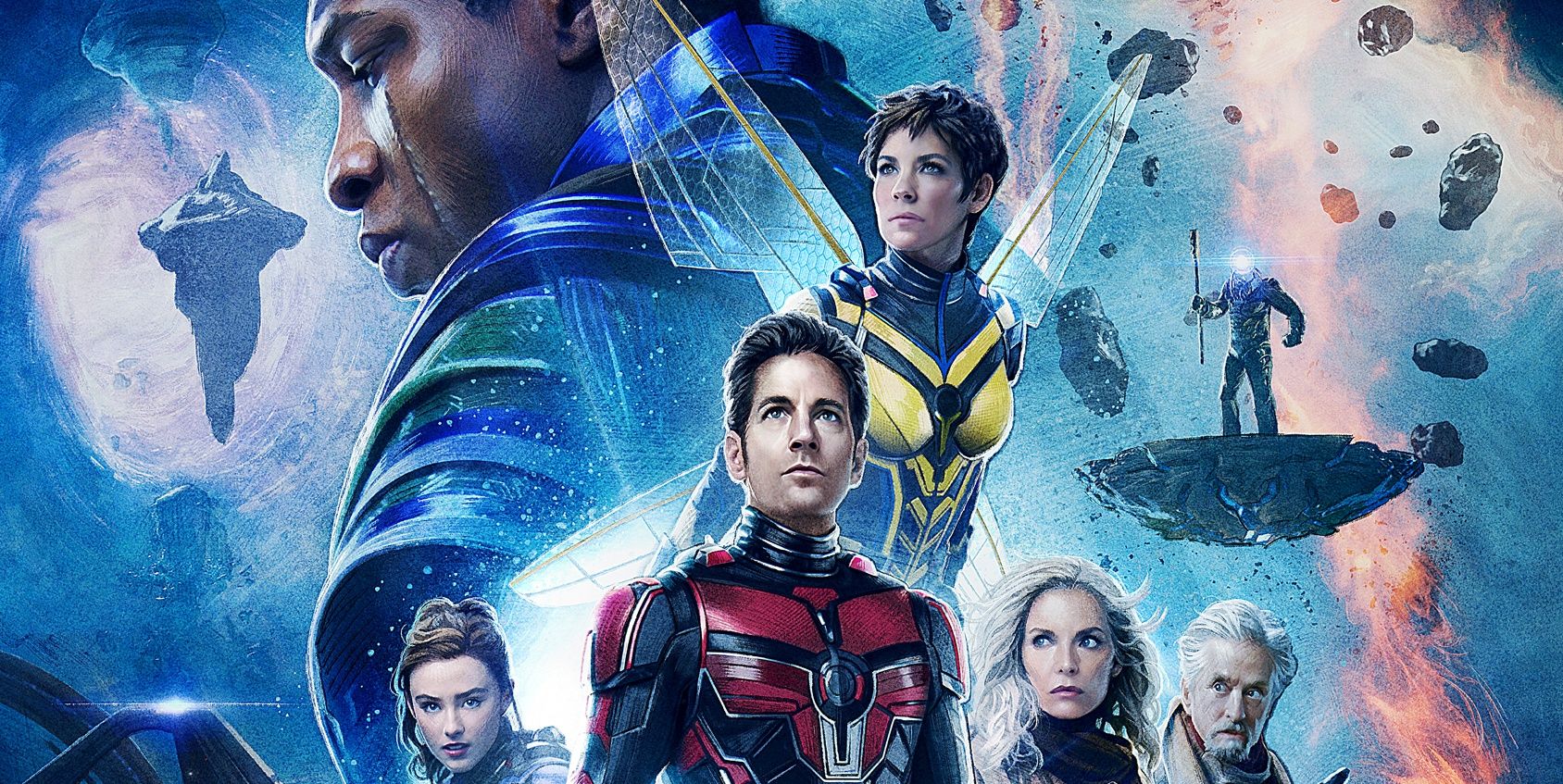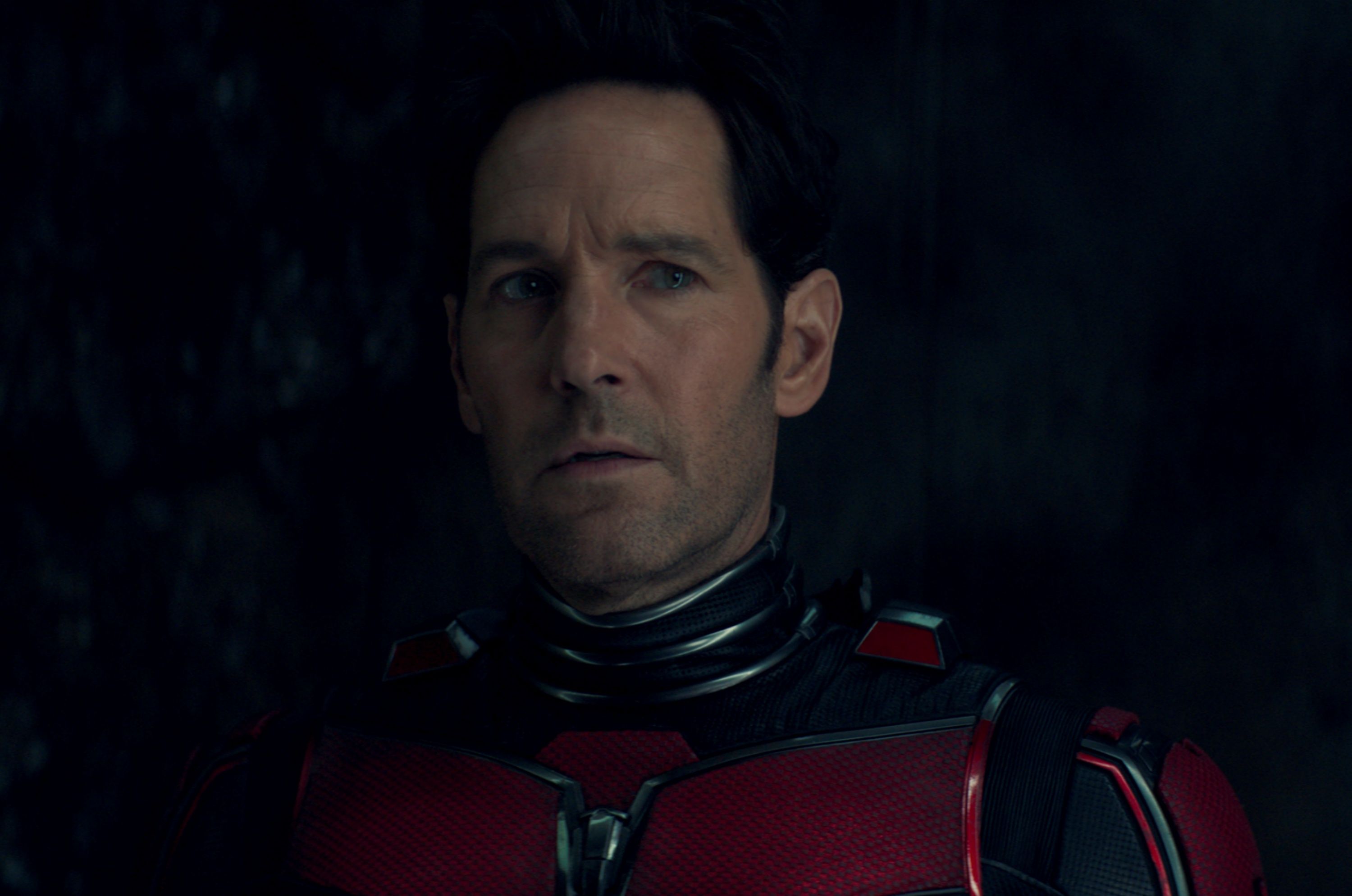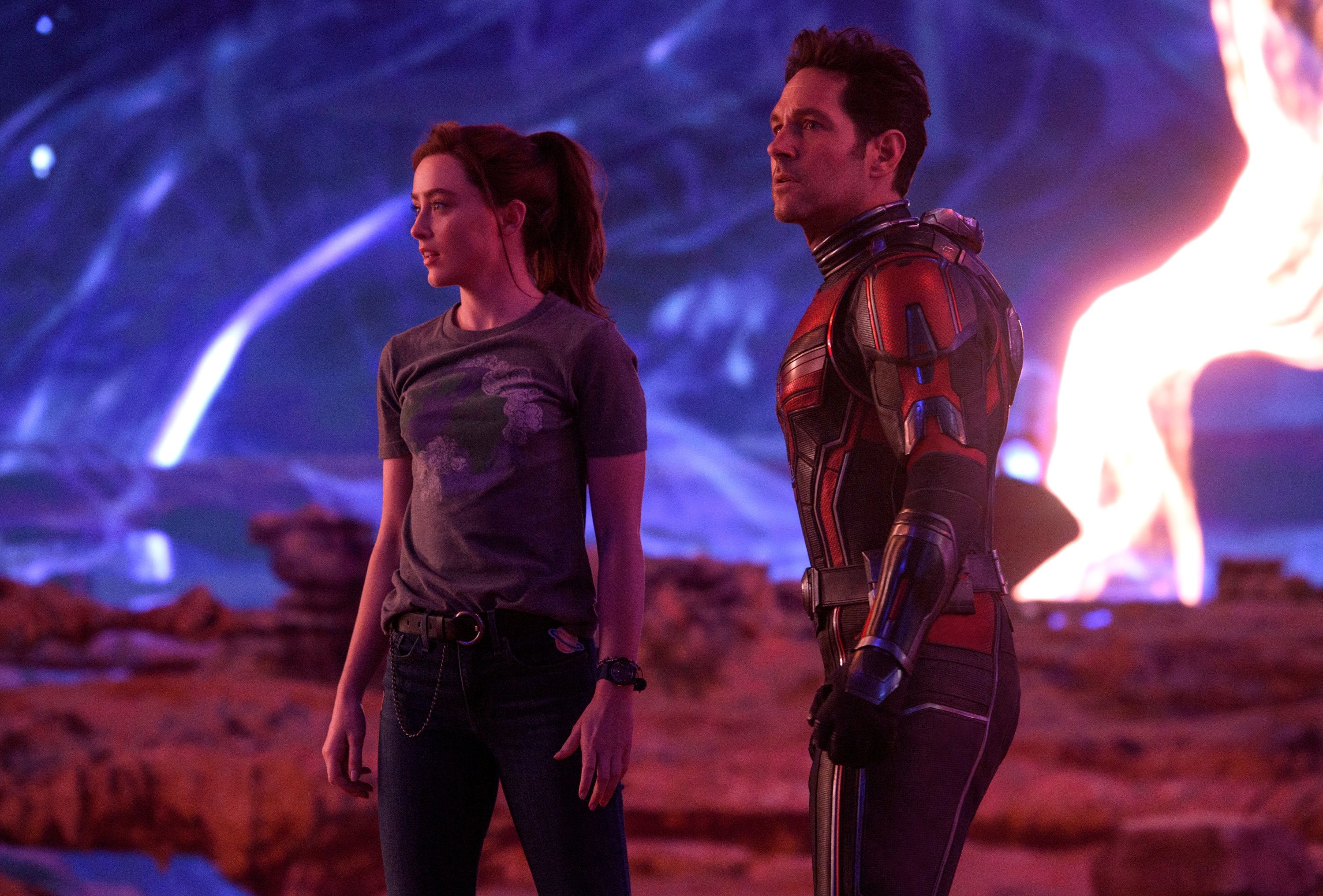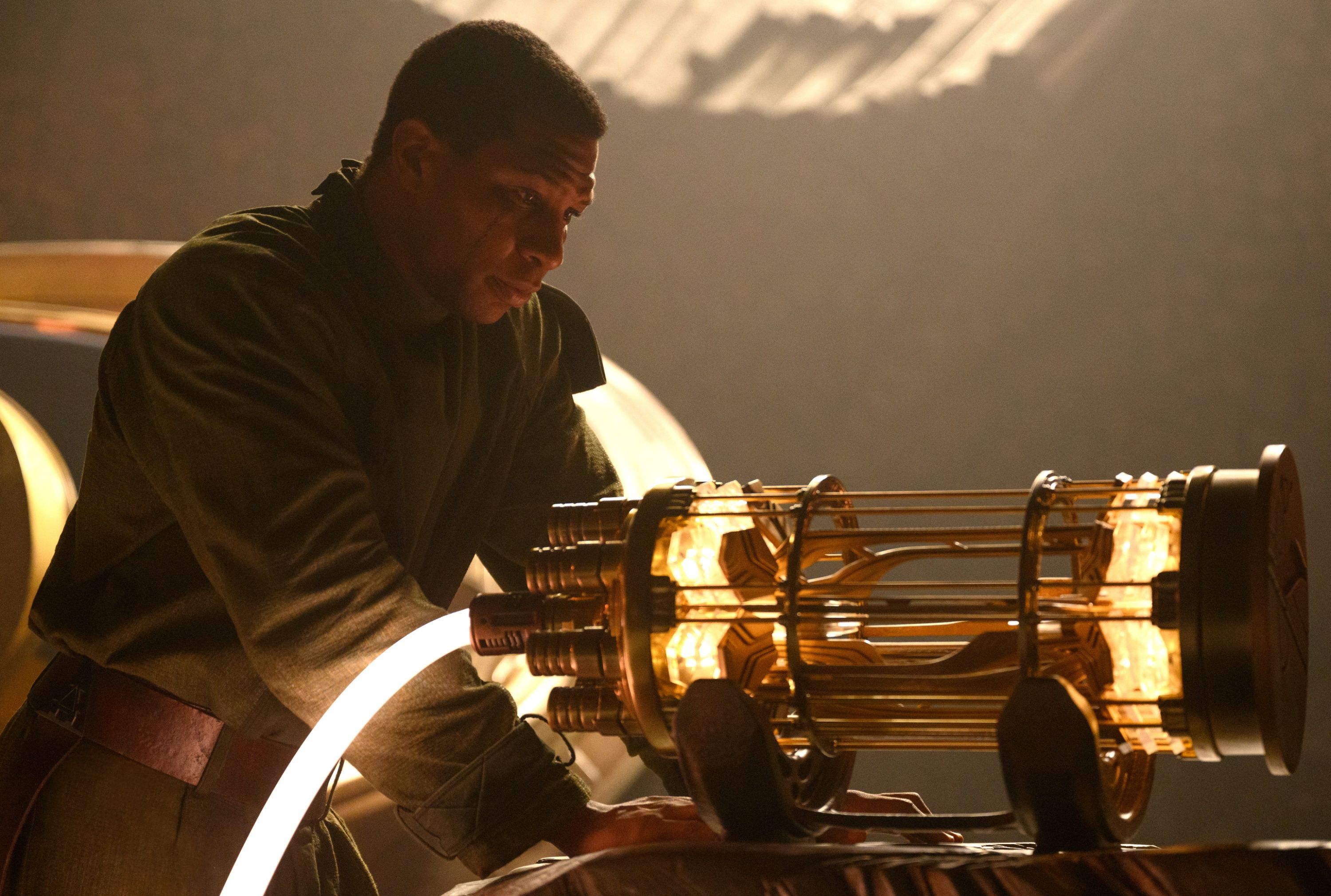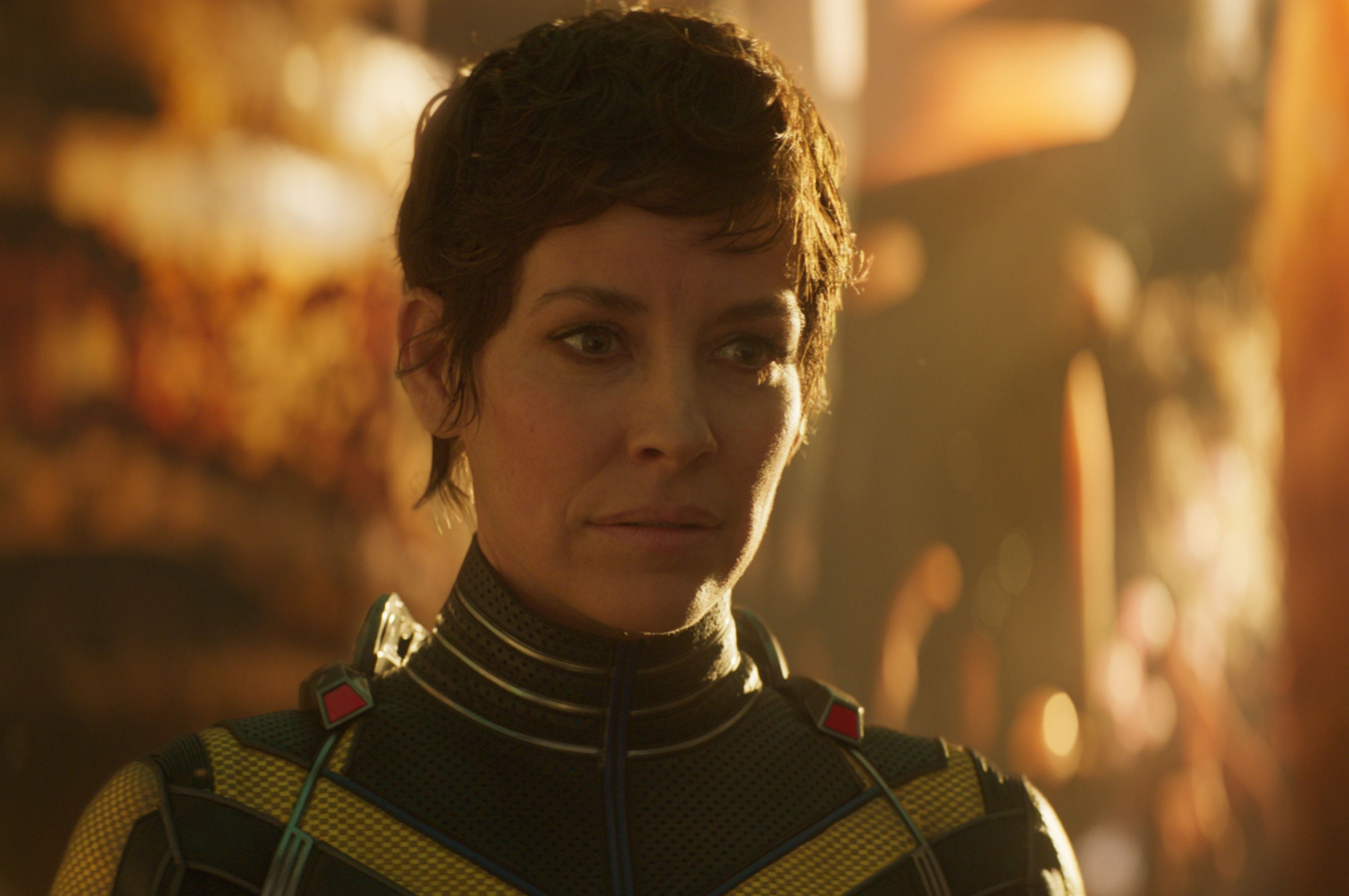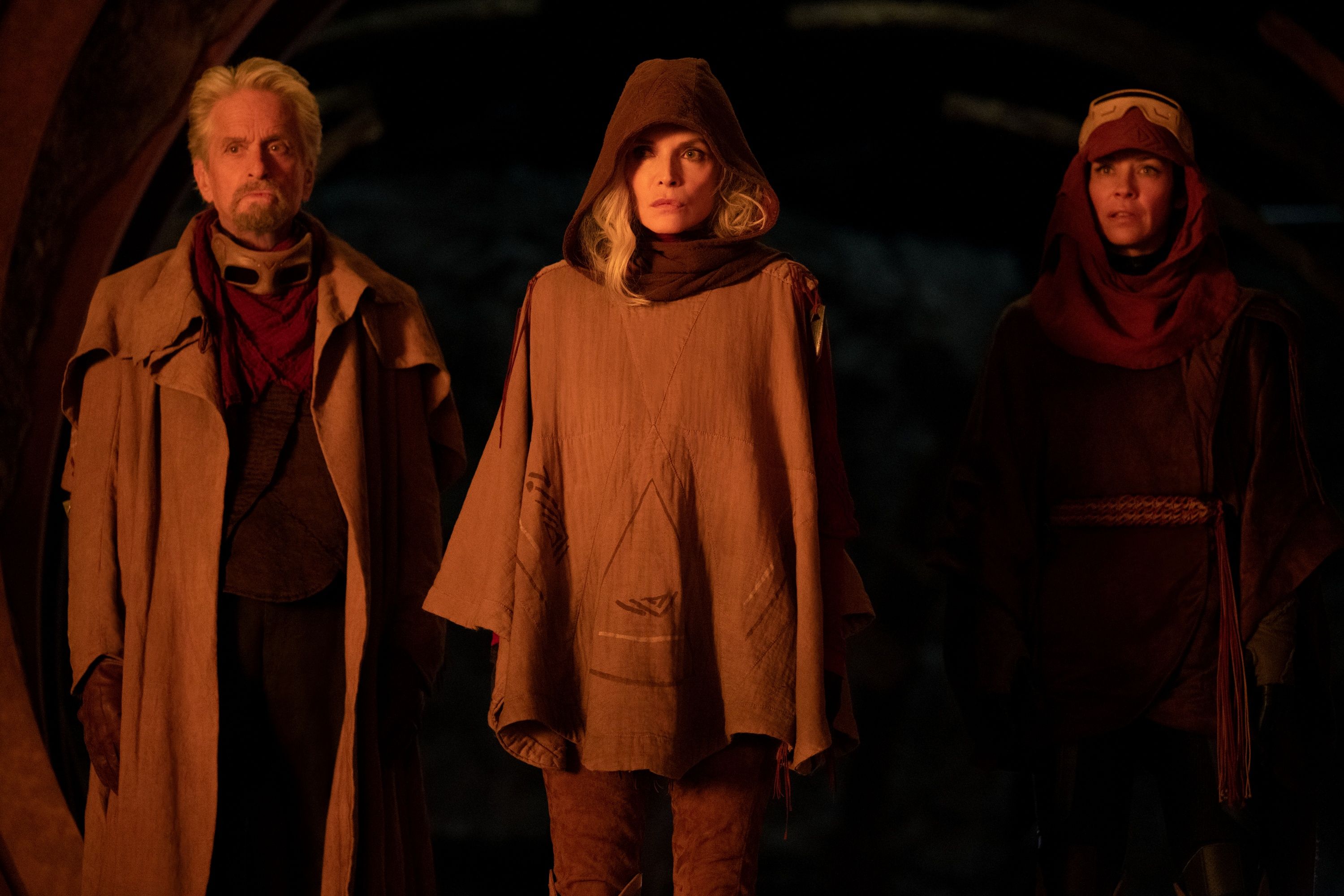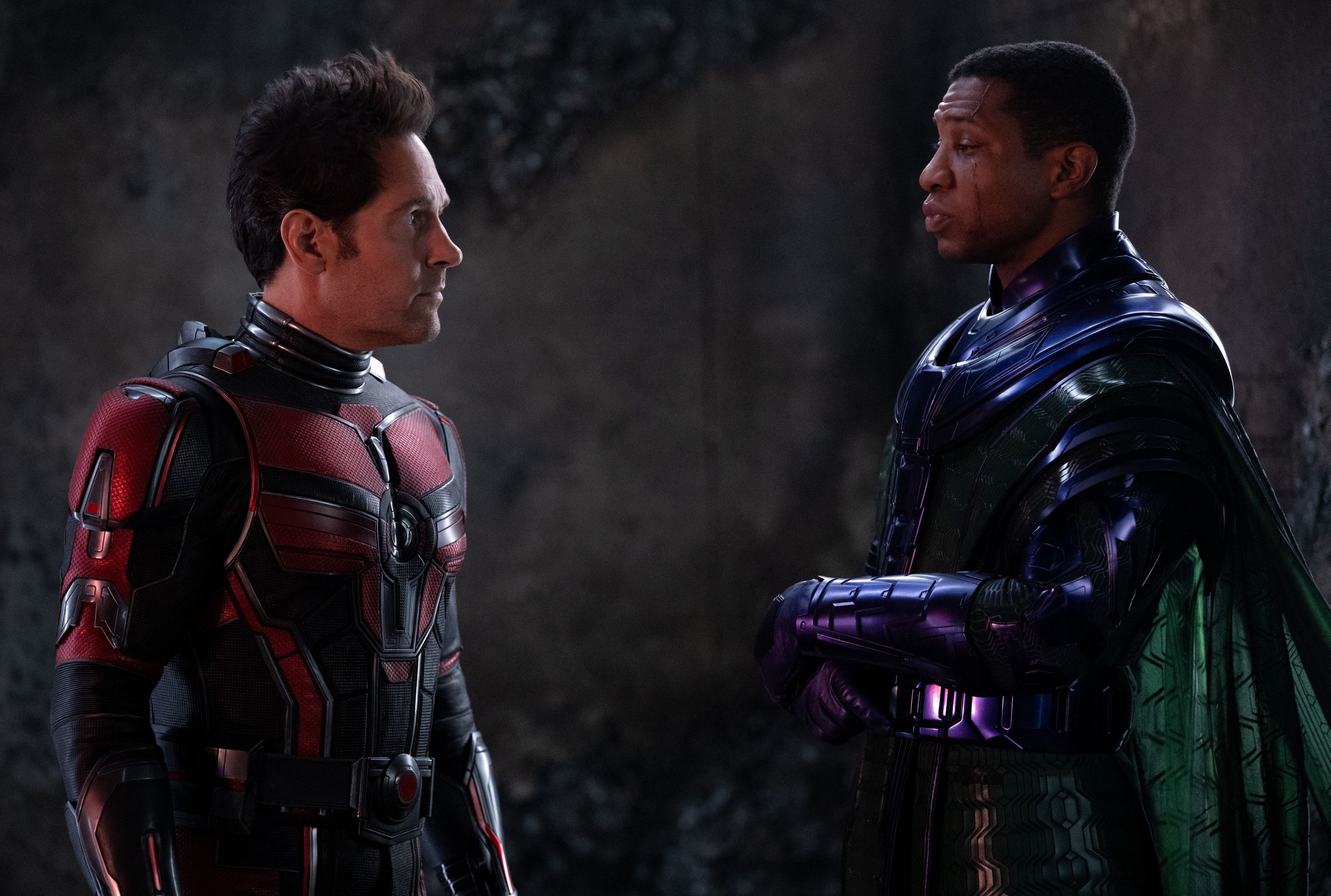The latest installment of the Marvel Cinematic Universe, Ant-Man and The Wasp: Quantumania, sees Scott Lang (Paul Rudd) and Hope Van Dyne (Evangeline Lilly), along with Hope’s parents, Hank Pym (Michael Douglas) and Janet Van Dyne (Michelle Pfeiffer), and Scott’s daughter Cassie (Kathryn Newton). As they venture deep into the Quantum Realm and cross paths with strange new creatures, they come face-to-face with Kang the Conqueror (Jonathan Majors), a complicated and mysterious villain with a terrifying level of power that has yet to be fully explored.
During this press conference to promote the newest Ant-Man movie, Rudd, Lilly, Newton and Majors were joined by director Peyton Reed and Marvel Studios President Kevin Feige to talk about the evolution of these characters over three films, how Scott Lang feels about being a superhero, diving deeper into the Quantum Realm, developing its wild look, how Kang the Conqueror fits into all of this, the father-daughter dynamic with Scott and Cassie, how this film became the starting point of Phase 5, and introducing MODOK.
Question: Peyton, as the director of the Ant-Man movies, you’ve helped shape these superheroes and their adventures from the beginning. What would you say is the signature of these movies, and how does Quantumania continue that while amplifying everything we know about Ant-Man and the Wasp?
PEYTON REED: The Ant-Man movies have really always been about family. It is a generational story about a family of heroes, with Scott Lang, who is not a billionaire or super scientist or anything, getting sucked into this world, and Hope van Dyne, who is the legacy daughter of two superheroes, Michael Douglas and Michelle Pfeiffer. It’s this generational thing, and now there’s young Cassie Lang, who is probably Scott’s biggest motivating factor of, having time with his daughter. He wants to be a hero, obviously. He’s an Avenger. But it’s really about work-life balance and also finding time with his daughter. That’s the most important thing. In this movie, Cassie Lang is 18, but we continue the story of this family. One of the things we’ve done in Quantumania is really broaden that story and start talking about the secrets the family members keep from each other, that they don’t tell each other. At the beginning of the movie, very quickly, we find out that maybe Janet hasn’t told the family about her 30 years in the Quantum Realm, and maybe Hope and Hank have not told Scott about what they’re working on with Cassie down in the basement, and maybe Cassie hasn’t told her dad about time she might’ve spent in jail. Everyone is keeping secrets from Scott, at the beginning of the movie. And then, suddenly, they’re thrust into the Quantum Realm and they have to work out these family dynamics while being in this bizarro, wacked-out world. But it really is the theme of family that is the constant in the movies.
Paul, how have Scott’s feelings about being a superhero changed, since the very first Ant-Man in 2015?
PAUL RUDD: Being a dad is his main focus. He always had a love-hate relationship with it, but now, I feel as if he’s accepted it. He is happy that all of that seems to be in the rearview mirror, and now they get to have a normal life and have some time together. That obviously doesn’t last as long as maybe he thought it would. But I think that he’s grown a lot, over the course of nine years or so that we’ve been doing these movies. This is a guy who started off with a regular job. He was brought into this group and has no innate super abilities, but then he went up and fought Thanos, so he’s experienced a thing or two, and he’s accepted who he is. When we start this movie, it’s present day. The events of Endgame have already transpired. I wouldn’t say he’s taking a victory lap, but others might say that. And he’s written a book, a memoir called Look Out for the Little Guy. He’s explained everything that’s been going on in life and his experiences with the Avengers, but now he’s ready to have some time to be a normal dad. There are some issues there because we missed out on a lot and I wanna recapture some of those years. Cassie’s older and she has ideas of her own, so we’re trying to kind of grapple with all of that.
Evangeline, how has Hope van Dyne evolved, since audiences first met her? What is she doing in Quantumania, as the movie gets underway?
EVANGELINE LILLY: Hope started the first Ant-Man film as a very cold, detached, very isolated woman. She didn’t have a lot of relationships in her life. She had a lot of broken relationships in her life. And over the course of these three films, I’ve had this incredible arc to be able to play, where she has, in that time, repaired her relationship with her father, she’s reunited with her long-lost mother, she’s fallen madly in love with Scott, and she’s become a stepmom to Cassie. Her life is just full of relationships, and it’s full of love. She’s really a blossomed version of the woman that we met, and you see that in the work that she’s doing in the world. She’s thriving and taking that love and spreading it around by trying to do right in the world and fix issues that are massive, like global warming and housing crises, and she’s doing it with success. And then, there’s this little hiccup. There’s this little missing piece, which is that she had always fantasized about her mom coming home, one day. Because that fantasy started when she was 8 years old, it was like, “We’re gonna be best friends, and she’s gonna tell me everything, and we’re just gonna be so close.” And then, she really keeps Hope on the outside, which is a wound that’s festering, at the beginning of the film.
Kevin, a lot of this movie takes place in the Quantum Realm. What exactly is the Quantum Realm, where have we seen it before, and what does Quantumania reveal about it?
KEVIN FEIGE: We first saw it in the first Ant-Man film. I was reminded recently that this was an idea that Paul had, early on, before we started filming the first Ant-Man film, to explore this and quantum mechanics, which I’m happy to discuss at length today, if you guys want. Things act very differently at the quantum level, and Paul was talking about the amount of storytelling and imagination and fun that you could have there. The first Ant-Man movie was mainly about meeting the characters and the origin story, but at the very end of that, we got a taste of it, and that’s what led to where we took it in Endgame. It’s a place that is on the subatomic level, where space and time act differently. That allowed us to time travel at Scott Lang’s suggestion in Endgame, and it allowed us to have this entire manic quantum-ness in this film, where we go to a point that only Janet had ever seen before and didn’t talk about it too much. There’s an entire universe below the surface, where we meet all sorts of fun, crazy characters.
The Quantum Realm has a very specific, really amazing, mind-blowing look and feel to it. What influenced that look?
FEIGE: It’s been in the works for three and a half years, taking audiences to a place that they have not been before. We talked about parallels to The Wizard of Oz a lot, in terms of taking and meeting a family down there. But the visuals, which have been in the works for a very long time, were all Peyton and his team.
PEYTON REED: We looked at everything from electron microscope photography, to things like Heavy Metal magazine in the ‘70s and ‘80s, and we wanted to bring in all of those elements. There’s a little sword and sorcery element. There’s a real Mobius element to it. We just wanted to assemble a team of artists to create the Quantum Realm. None of the other Marvel movies have really dealt with it, so we wanted to create this very vivid world that has its own internal history and internal logic. Who are the creatures there? Who are the people there? How do you travel? What are the laws of physics? All those things needed to be figured out. With Will Htay, our production designer, we assembled this insane group of visual artists. We said, “Bring some of your most fantastic ideas to the table and let’s figure out what it can be.” We wanted to take these characters that the audience has come to know, and send them on this journey and traverse these very strange lands, and just have fun with it. It was a part of the MCU that we were free to create on our own, and that was one of the most exciting things about it.
Were there any sci-fi influences, as far as other movies or TV shows, when it came to the look?
REED: For the Quantum Realm, we really drew from a lot of stuff, like Flash Gordon, Barbarella, and all sorts of whacked out things. We looked at the covers of old science fiction paperbacks from the ‘60s and ‘70s, and into the ‘80s. There are a lot of great artists who would paint the covers for these things, and they would be at a newsstand and that cover had to grab you. A lot of them were creating these really strange worlds, that if you were looking at paperbacks, would pull you in. You may not even know what the story is, but there was that visual. So, I looked at a lot of those artists. And Heavy Metal magazine had all these artists, from all over the world, not only from the states, but from France and Germany, and everywhere. They formed a collective, and there was some striking imagery in all of that stuff. And then, we looked at real world microphotography and electron microphotography, which takes things that are so incredibly small that, when you print them out, look like landscapes. It sets your mind thinking, which is where all of our minds had to be, of this movie taking place in your fingernail somewhere. It’s this subatomic world where all this stuff is going outside of space and time, but in the Quantum Realm.
Janet van Dyne describes it, at one point, as worlds within worlds. It’s this idea that there’s this infinite world of worlds down there, that are inhabited by creatures and things. So, it really was taking into account all of those things and bringing together this group of artists who had their own crazy things in their portfolios. It was like, “Well, this is a cool looking design. Could we work this into the Quantum Realm?” We needed to do something that really felt vast and where you’re in one environment, and that feels like a Quantum jungle. It feels like something else, altogether. These are some weird mines that are mining some kind of energy that Kang and his forces are using. We just wanted to make as vivid a world as possible, so we drew from a lot of different things. At the beginning, we had no idea what it was gonna look like. When we started going into Marvel and seeing some of those photographs on the wall, I thought, “Wow, these are incredible mockups. This is the craziest landscape.” And they were like, “No, that’s actually an electron microscope. That really is what it looks like.” It’s really not that much of an embellishment. It looks insane. We have all seen versions of that, when we see really closeup stuff.
Jonathan, can you explain Kang the Conqueror and the concept of variants?
JONATHAN MAJORS: Who is Kang? That is a question that we will all be answering for a very long time. The quick answer to that is Kang is a time traveling super villain who is also a nexus being, which leads to this idea of variants. There are multiple versions of Kang, versions being variants. They occupy different universes, multi-verses, and have different intentions. They are all different beings, and yet something that we’re still and I’m still working on and continue to refine, have something of a throughline between them that, to me, is the Kang gene. Kang the Conqueror is stuck in the Quantum Realm, and he has some issues with some variants and is not happy about it. When he was down there, he met Janet.
What’s your approach for playing him, as an actor?
MAJORS: This really feels like joining a Shakespearean troupe, back in the day, when you have Shakespeare in the room, and you’ve got other guys in the room, and Shakespeare has a very clear idea of what it is he wants to do. And then, you have your lead actor, and they set the tempo and the tone that you get in. The culture of the play and the story is all there, but it’s changing, so you really have to be very clear about what it is that you’re doing and who the spine of the character is, what he or she is about, and what they’re going after. You build that, and you just play hard. At least that was my take. You play hard, and if everything turns left, you turn left. Kang gotta Kang. That’s the approach. It’s the same as all the other pieces of the people I’m blessed enough to play. Kang is just different, in so far as he lives in a very different world.
What’s it like to enter the MCU, playing someone as big as Kang. How is it to live up to such high public expectations?
MAJORS: It’s deep. We, as artists and creators, make it for the people. We are the people, and we make it for the people. We always make it with good intentions. There’s something good in it. You may not see it right away, but it’s in there. This is cool because it’s a big order. The MCU has established itself as not just a national pillar, but an international pillar of culture and education and entertainment. To be Kang, and to come in with that, you realize it’s been pushed that far with so much strength, power, and support. That’s what I feel. I feel the support of it. I’ve also lived a life, so I just have a certain temperament, which is helpful. I’ve also been surrounded by individuals, from the beginning, that really support Jonathan to step into Kang. I’m learning, more and more, that the fans and those who follow this world really love it and they really have an open heart about it. Because there’s so much good in it, it’s gonna work, so I don’t really think about it much, except for that whole monologue I just gave.
Kathryn, did you dream of playing a superhero, prior to being cast as Cassie?
KATHRYN NEWTON: Iron Man was the first Marvel movie I saw, and I was probably eight. Since then, I’ve always wanted to be a Marvel superhero. Anyone who knows me from high school, it was probably my superlative in the yearbook. I really wanted to be a part of this because it made me dream. I went with my dad to the theater, and I just wanted to be a superhero. It’s funny because I wanted to be the biggest Marvel superhero of all time, and it’s ironic that Cassie Lang grows 40 feet. I’m proof that your dreams come true because mine did.
More than just playing a superhero in this movie, there’s the father-daughter relationship with Scott and Cassie. How did you and Paul Rudd bring that dynamic to life?
NEWTON: It was really difficult, working with Paul. I couldn’t get through scenes because I was laughing the whole time. It was very difficult for me to stay grounded in my character. Luckily, when Jonathan was on set, he really brought the music and made me get into it. It was very easy to find that dynamic with Paul. The first day, our first scene was the hardest scene in the movie for me. I really just trusted Peyton Reed, our director. He believed that I was Cassie Lang when I don’t think that I did. I didn’t believe it, when I got the call to be in the movie. I didn’t believe it, when we filmed it. [I’ve seen it twice and] I still don’t believe I’m in it. I don’t know how it happened, but I really loved the movie, and I loved making it.
Kevin, what made Ant-Man and the Wasp: Quantumania the right choice to begin Phase Five and introduce the next iconic Marvel villain, Kang the Conqueror?
FEIGE: Phase 4 was about introducing a lot of new characters and new heroes to the world. We want to kick off Phase 5 with a third film of characters that were already beloved, which this team certainly is, and utilize them. We’ve talked about family. That goes along with vulnerability and relatability. And who better to face off against one of, if not the biggest villain the MCU’s ever faced than this family who you might think could not handle it? And then, we learn, over the course of the movie, that Janet has not only handled it, but has been dealing with it for decades. In terms of the Ant-Man trilogy, there’s a flashback in the first film to the original Wasp, Janet Van Dyne. We don’t see her face. She’s wearing a mask. It was always our dream that someday we could make another movie, and then Michelle Pfeiffer could play that character. We get a little more of a taste of that in Ant-Man and The Wasp. And now, with this movie, there’s a large part of this movie where Peyton and the screenwriters just hand the movie over to Michelle, and it’s amazing. I keep thinking back to those first scenes on the first Ant-Man film, where it was just a dream and a possibility of who could play this part. But all of these characters, and these amazing actors, we felt would be a great audience surrogate to meet somebody as complex and scary and multiversal as Kang.
Why was it important that Scott Lang be the first Avenger to have a run-in with Kang?
FEIGE: It’s the notion of the everyday quality, and the person who’s grown and continually surprised himself and the world around him, facing off against somebody that is near unbeatable. I also like that Scott can take a punch. You forget the very first thing that happens to Scott, in this film series, is a punch to the face in prison. I love how that was all a setup to a massive battle that you see between them, in this film
Paul, after three Ant-Man films, what do you like most about Scott Lang, and is there anything you dislike about him?
RUDD: What I like most about him is that he’s a regular guy who still has reservations about all of this. He’s just a dad. I like the fact that he is a part of this group with some pretty impressive people, and superheroes, and that he would be the first guy to say, “What the hell am I doing here? This makes no sense at all.” He’s a real person, so as an actor, you want to play somebody who’s relatable, hopefully a sympathetic person, and somebody were you understand maybe what they’re going through. I like that. I like playing the father aspect. I like trying to wrap my brain around the situation that I find myself in. His human quality is the thing that I like the most. As opposed to his cyborg quality, which is the part I don’t like. No. There’s nothing about the character that I don’t. I like the guy, but I’m biased.
Jonathan, what preparation did you have to do, to capture the distinctness of the different Kang variations?
MAJORS: The prep really comes down to who my director is and who my hero is. As an antagonist, we’re following our heroes. In this case, I had a few to look at and break down, which is the fun part. I look at them and I figure out, “Okay, you can’t antagonize somebody, if you don’t know who they are, if you don’t know what’s the opposite of them, and if you don’t know what their hopes and dreams are.” My objective is to do that, to antagonize, in order to get what I need to fulfill my life and my dream. In Loki, I’m dealing with Tom Hiddleston]. That was great. It’s He Who Remains and Tom. I got to watch him, the whole time. This opportunity came to me in lockdown, so I studied Tom Hiddleston, for hours a day. And then, when that was done, I went, “Okay, Paul Rudd, you’re up.” I studied him, and I studied all of his hero colleagues and compatriots. And then, you speak to your director and even your producers. There’s a culture to it, so you lean into that. Kang has to relate to him first, as a man and as a human being. He relates to all of them as a human being. Then, we can combat, and I can get him to do what I need him to do, perhaps.
Evangeline, when is the Wasp’s standalone film coming, or the women of Marvel?
LILLY: This is an excellent question. I think you might have asked the most important question of the day. I’m going to defer this question up the line to Kevin.
FEIGE: Well, the opportunities within the MCU are endless, as they are in the multiverse. We will have to see what happens in the future.
LILLY: And just for the record, if that opportunity did present itself, I’m fully suited up and ready to go.
Kathryn, Cassie is so smart and confident in her intelligence, but we also get to see where her morals lie and her desire to help people. What was your favorite part of getting to bring that aspect of Cassie to life?
NEWTON: She has a really good heart. That’s my favorite thing about Cassie. She definitely leads with her heart. And even though she’s really smart, she doesn’t think too much about what she’s doing. She just wants to do the right thing, and it makes her really impatient, and a lot like me, which causes her to make mistakes. She wants to be like her dad. She thinks her dad’s the greatest, but she will never tell him that, obviously. It was great to try and exercise both of those. My favorite thing is that she’s a regular person, just like her dad. She’s still figuring it out, just like me.
Peyton, what was it like to introduce MODOK?
REED: For me, it was a personal thrill. I was a kid who spent a lot of my childhood alone in a room reading Marvel comics, and MODOK was always this insane character. And he’s grotesque. He’s a giant head that has been turned into a mechanized organism designed only for killing. That was intriguing. So, we started talking about whether there was a place in the MCU, in the Ant-man movies, for a live-action version of MODOK, what that would look like, and how we would go about it.
Ant-Man and The Wasp: Quantumania opens in theaters this Thursday.

